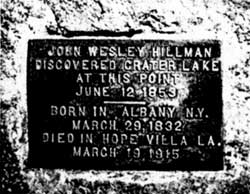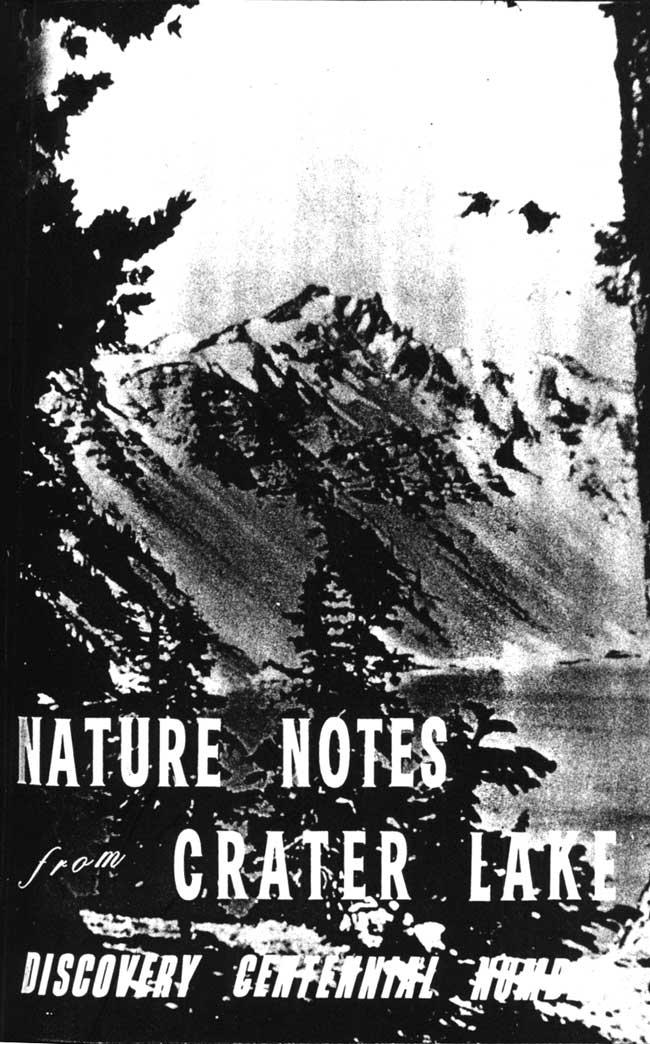Volume 19, 1953
All material courtesy of the National Park Service.These publications can also be found at http://npshistory.com/
Nature Notes is produced by the National Park Service. © 1953
Crater Lake Discovery Centennial
Gold! Gold! That cry rang across the United States in the late 1840’s, and Mr. Wesley Hillman heard the call and responded. He set out for California from New Orleans in 1840 – – taking his young son, John, along (see inside Front cover). The party followed the Old Immigrant Trail and crossed the Rockies via the South Pass. Young John later recalled seeing thousands of buffalo and remembered the stampedes. Three months passed before the group reached the area where the waters flow west. Soon they arrived at the Columbia River and used it as their avenue to the West. Mecca of the West at this time was San Francisco, as for thousands of prospectors, the destination of the Hillmans. An exciting trip along the coast on various craft carried John and his father to San Francisco.
John Wesley Hillman soon departed from his father to search for a strike that could bring wealth in a day. Having only moderate success as a prospector, John Hillman shifted from job to job for the next three years. While driving mules for an ungrateful, penny-pinching, pioneer business man, John Hillman received word of a California party secretly purchasing supplies near his home in Jacksonville, Oregon.
A prospecting party quickly organized and decided to follow the California group on their search for a rumored fabulous Lost Cabin Mine. The Californians soon realized they were being followed and began scattering through the brush, camping in inaccessible areas and using a series of other pioneer tricks in the attempt to shake off the pursuing Oregonians, but to no avail.
One June day in 1853, when both parties had scattered and were searching for landmarks which would lead them to the mine, John Hillman approached close enough to bid one of the Californians a good day. Soon after this incident the groups settled their differences and united. Supplies of both groups were low so it was decided to allow three men from each party to gather as many provisions as possible and make one final search for landmarks.
On June 12, 1853, this group, including John Wesley Hillman, climbed the west slope of the mountain now called Mazama and became the first white men to gaze upon this circular sea of indigo later to be named Crater Lake. John Hillman stated that if he had not borrowed an exceptionally fine mule from a friend, he would not have been the first man to see the lake. Hillman was so surprised to find a lake he had noticed in the distance that he failed to look down; his mule suddenly stopped and he was about to spur the animal when he glanced over the rim an noticed the 1,000 foot drop. Had his mule been blind someone else would have discovered Crater Lake!
 Hillman Plaque |
Recovering from the initial impact of finding this unusual lake, the group assembled and two names were suggested. Mysterious Lake and Deep Blue Lake were voted on and the latter was chosen as the first name of the Lake. Hillman suggested descending to the water’s edge, but his exhausted and hungry companions vetoed this idea and the group started home to Jacksonville. The excitement of Indian wars and the discovery of gold, plus the fact that there was no newspaper published in the area allowed their discovery to be quickly forgotten.
The United States was well launched into the Civil War by the year 1862. Prospectors, settlers and westerners were hardly affected by the war and it was in that year that Chauncey Nye and his party were heading south from the John Day Basin area in search of water. They came upon the rim of the Lake and thought of using it as their source of water. However, they decided to use melted snow for their water supply, as they soon realized the tremendous distance to the water.
The Nye party drew a crude map of the area as they moved around the rim and they called the Lake simply Blue Lake. Enroute to Jacksonville, Chauncey Nye and three others noticed a very rugged peak which they climbed and named Union Peak. A majority of the group favored the Union cause in the Civil War and they hoped the name of this volcanic plug would never change. Following the usual slow route of travel to Jacksonville, Oregon, the Nye party reported their discovery and on November 8, 1862, in the Oregon Sentinel, the first printed article about the Lake appeared.
The Civil War had spread to the West to a considerable degree by 1865, both the Confederacy and the Union Army having sent men to the West in search of horses. Captain B. F. Sprague, Company I of the 1st Oregon Infantry, had been detailed to build a road from Fort Klamath to Jacksonville. He sent F. M. Smith and John Corbell to hunt game in the area because the fresh meat supply of the Company was getting low. While on this hunting trip, these two men came upon the Lake. They returned and told of their discovery. This news was passed on and so excited several members of the Company that they decided to visit the Lake at their earliest convenience.
Meanwhile, the Snake Indians in the Steens Mountain area had one of their frequent uprisings. Captain Sprague and five volunteers headed for the troubled territory and decided to visit the mysterious lake on their return. Captain Sprague suggested that the group descend to the water’s edge and a friendly race soon developed, Orson Stearns being the victor. Since Stearns was the first to reach the water, he was given the honor of naming the lake. With appropriate ceremonies it was called “Lake Majesty”.
In the course of the next four years, reports reached many scattered towns and settlements concerning this large sunken lake and the lonely island cinder cone on which the foot of man had never trod. Our early western settlers had a spirit of adventure found only in an energetic and colonizing group. These reports excited John Sutton, and in 1869 he organized a party with the specific purpose of visiting the Lake, Carrying a knocked down boat which they assembled at the shore of the Lake, they rowed over to, named and explored Wizard Island. The Sutton party wrote an account of their trip, placed it in a tin can and left it in the rocks of the island’s crater. After exploring the island they decided to sound the Lake. They made several soundings, but soon decided their craft was too frail for such a job. From those taken, however, they estimated the lake to be 2,000 feet deep and later official soundings indicated they were very nearly correct.
John Sutton’s patty christened the blue waters “Crater Lake” and also took the first photograph of the lake. In 1872, Crater Lake was visited by the Applegate party, which included Leslie M. Scott, Lord Maxwell of Scotland and Dr. Munson. Applegate Peak and Munson Point were named by this party.
Hillman, Nye, Sprague and Sutton are names important in the discovery of Crater Lake, but the development of this area was to rely on a man of steel convictions, William Gladstone Steel, later to become known as the “Father of Crater Lake National Park”. His association with Crater Lake began as a boy in his teens. Will carried his lunch in a newspaper rather than a dinner pail because he did not like carrying a cumbersome pail five miles home from school each day. One noon, forced inside by inclement weather, Will Steel was reading various articles in a newspaper wrapped about his lunch when his attention focused on an article of a mysterious lake in a crater somewhere in Oregon. Will Steel read the article over several times and while walking home to the ranch in Kansas the curiosity and desire to visit this mysterious lake increased with each step. Once home, he talked about that lake continuously and eventually resolved to see it.
He never forgot this boyhood vow and when, at the age of eighteen, his family moved to Portland, young Will Steel immediately started a search for information about the lake. It was not until four years later that the information necessary for a visit to the lake was found. William Steel was employed at a local publishing firm when C. E. Watson stopped in the office to visit a friend and told of his visit to the lake. Of course, Will Steel obtained all information possible. He learned of two ministers planning a visit to the lake and asked to join the group.
In 1885 Will Steel finally saw the watery gem of the Cascades, the rim and the Lake, a place he was to know so well that it was to become a major part of his life. Humbled and inspired by the heavenly blue color of the lake, he soon conceived the idea of preserving this area for all the people, for all time. A national park there was the dream of William Gladstone Steel.
“What was necessary to develop this area into a national park?” he asked himself. Most important at this early date was the publication of its beauty, to announce its grandeur and then to establish its location. Closely connected with these steps were the publication and improvement of the routes of accessibility. To those few who had visited the area, the beauty and the glory of nature’s handiwork were as impressed on their thinking as the effects of the master architect, erosion, or the results of glacier and volcanic action evident everywhere in the vicinity of the lake. William contacted these people and asked them to contribute articles to various organizations concerning these wondrous sights and, more important, information establishing the definite location of available routes to the lake.



